Modeling and Validation of Total Ionizing Dose Effect on the TSVs in RF Microsystem
Abstract
:1. Introduction
2. Theoretical Analysis
2.1. Structure of TSVs
2.2. TID Effect on SiO2
2.3. The Capacitance of TSVs after Irradiation
3. Modeling of TSV Structures and Simulation
3.1. Modeling of TSV Structures
3.2. Simulation and Analysis
3.2.1. Effect of Irradiation on TSV Capacitance
3.2.2. Effect of Oxide Thickness on Irradiated Capacitance
3.2.3. Effect of Substrate Doping Concentration on TSV Capacitance after Irradiation
4. Irradiation Experiment and Analysis
4.1. Design of Irradiation Experiment
4.2. The Results Tested before and after Irradiation
4.3. Analysis Based on the Experiment and Measured Data
5. Simulation Based on HFSS and Analysis
5.1. TSV Modeling in HFSS
5.2. Simulation in HFSS
5.3. Analysis Based on Simulation and Irradiation Experiment Results
6. Conclusions
Author Contributions
Funding
Data Availability Statement
Acknowledgments
Conflicts of Interest
References
- Jagannathan, S.; Loveless, T.D.; Zhang, E.X.; Fleetwood, D.M.; Schrimpf, R.D.; Haeffner, T.D.; Kauppila, J.S.; Mahatme, N.; Bhuva, B.L.; Alles, M.L.; et al. Sensitivity of High-Frequency RF Circuits to Total Ionizing Dose Degradation. IEEE Trans. Nucl. Sci. 2013, 60, 4498–4504. [Google Scholar] [CrossRef]
- Peng, C.; Hu, Z.; Ning, B.; Huang, H.; Zhang, Z.; Bi, D.; En, Y.; Zou, S. Total-Ionizing-Dose Induced Coupling Effect in the 130-nm PDSOI I/O nMOSFETs. IEEE Electron Device Lett. 2014, 35, 503–505. [Google Scholar] [CrossRef]
- Jazaeri, F.; Zhang, C.M.; Pezzotta, A.; Enz, C. Charge-Based Modeling of Radiation Damage in Symmetric Double-Gate MOSFETs. IEEE J. Electron Devices Soc. 2017, 6, 85–94. [Google Scholar] [CrossRef]
- Lee, M.; Cho, S.; Lee, N.; Kim, J. Design for High Reliability of CMOS IC with Tolerance on Total Ionizing Dose Effect. IEEE Trans. Device Mater. Reliab. 2020, 20, 459–467. [Google Scholar] [CrossRef]
- Feng, J.; Li, Y.D.; Fu, J.; Wen, L.; He, C.F.; Guo, Q. Effect of Total Ionizing Dose Damage on 8-Transistor CMOS Star Sensor Performance. Semiconductors 2021, 55, 108–115. [Google Scholar] [CrossRef]
- Budroweit, J.; Jaksch, M.; Borghello, G. Ultra-High Total Ionizing Dose Effects in a Highly Integrated and RF-Agile Transceiver. In Proceedings of the 2020 IEEE Radiation Effects Data Workshop (in Conjunction with 2020 NSREC), Santa Fe, NM, USA, 29 November–30 December 2020; pp. 1–4. [Google Scholar] [CrossRef]
- Li, Z.; Elash, C.J.; Jin, C.; Chen, L.; Xing, J.; Yang, Z.; Shi, S. Comparison of Total Ionizing Dose Effects in 22-nm and 28-nm FD SOI Technologies. Electronics 2022, 11, 1757. [Google Scholar] [CrossRef]
- Faccio, F.; Michelis, S.; Cornale, D.; Paccagnella, A.; Gerardin, S. Radiation-induced short channel (RISCE) and narrow channel (RINCE) effects in 65 and 133 nm MOSFETs. IEEE Trans. Nucl. Sci. 2015, 62, 32663–33270. [Google Scholar] [CrossRef]
- Zhang, C.M.; Jazaeri, F.; Pezzotta, A.; Bruschini, C.; Borghello, G.; Faccio, F.; Mattiazzo, S.; Baschirotto, A.; Enz, C. Characterization of GigaRad Total Ionizing Dose and Annealing Effects on 28-nm Bulk MOSFETs. IEEE Trans. Nucl. Sci. 2017, 64, 2639–2647. [Google Scholar] [CrossRef]
- Ma, T.; Bonaldo, S.; Mattiazzo, S.; Baschirotto, A.; Enz, C.; Paccagnella, A.; Gerardin, S. TID degradation mechanisms in 16 nm bulk FinFETs irradiated to ultra-high doses. IEEE Trans. Nucl. Sci. 2021, 68, 1571–1578. [Google Scholar] [CrossRef]
- Bonaldo, S.; Gorchichko, M.; Zhang, E.X.; Ma, T.; Mattiazzo, S.; Bagatin, M.; Paccagnella, A.; Gerardin, S.; Schrimpf, R.D.; Reed, R.A.; et al. TID effects in highly scaled gate-all-around Si nanowire CMOS transistors irradiated to ultra-high doses. IEEE Trans. Nucl. Sci. 2022, 69, 1444–1452. [Google Scholar] [CrossRef]
- Simoen, E.; Gaillardin, M.; Paillet, P.; Reed, R.A.; Schrimpf, R.D.; Alles, M.L.; El-Mamouni, F.; Fleetwood, D.M.; Griffoni, A.; Claeys, C. Radiation Effects in Advanced Multiple Gate and Silicon-on-Insulator Transistors. IEEE Trans. Nucl. Sci. 2013, 60, 1970–1991. [Google Scholar] [CrossRef]
- Fleetwood, D.M. Radiation Effects in a Post-Moore World. IEEE Trans. Nucl. Sci. 2021, 68, 509–545. [Google Scholar] [CrossRef]
- Yanruoyue, L.; Guicui, F.; Xiaojun, Y.; Weifang, Z. Thermodynamic Analysis of SiO2 Thickness’s Effect on TSV. In Proceedings of the 2018 19th International Conference on Thermal, Mechanical and Multi-Physics Simulation and Experiments in Microelectronics and Microsystems (EuroSimE), Toulouse, France, 15–18 April 2018. [Google Scholar]
- Li, K.; Zhang, E.X.; Gorchichko, M.; Wang, P.F.; Reaz, M.; Zhao, S.E.; Hiblot, G.; Van Huylenbroeck, S.; Jourdain, A.; Alles, M.L.; et al. Impacts of Through-Silicon Vias on Total-Ionizing-Dose Effects and Low-Frequency Noise in FinFETs. IEEE Trans. Nucl. Sci. 2021, 68, 740–747. [Google Scholar] [CrossRef]
- Liu, Z.; Swarup, S.; Tan, S.X.D. Compact Lateral Thermal Resistance Modeling and Characterization for TSV and TSV Array. In Proceedings of the 2013 IEEE/ACM International Conference on Computer-Aided Design (ICCAD), San Jose, CA, USA, 18–21 November 2013. [Google Scholar]
- Chen, G.; Wang, Z.; Wang, W. Influence of Different Materials on Thermal Stress of Conical TSV. In Proceedings of the 2018 19th International Conference on Electronic Packaging Technology (ICEPT), Shanghai, China, 8–11 August 2018. [Google Scholar]
- Shan, G.; Lu, Q.; Liu, S.; Yang, Y. Through-Silicon Capacitor Interconnection for High Frequency 3-D Microsystem. IEEE Trans. Compon. Packag. Manuf. Technol. 2019, 9, 1310–1318. [Google Scholar] [CrossRef]
- Yang, L.H.; Li, Z.M.; Fu, Y.; Li, G.L.; Lu, Q.J. Study of Total Ionizing Dose on RF Microsystem. In Proceedings of the 4th International Conference on Microelectronic Devices and Technologies (MicDAT ’2022), Corfu, Greece, 21–23 September 2022. [Google Scholar]
- COMSOL AB. Interface Trapping Effects of a MOSCAP, COMSOL Multiphysics® v. 5.4; COMSOL AB: Stockholm, Sweden, 2018; pp. 2–22. [Google Scholar]
- Cendes, Z. The development of HFSS. In Proceedings of the 2016 USNC-URSI Radio Science Meeting, Fajardo, PR, USA, 26 June–1 July 2016. [Google Scholar] [CrossRef]
- Paillet, P.; Touron, J.L.; Leray, J.L.; Cirba, C.; Michez, A. Simulation Of Multi-Level Radiation-Induced Charge Trapping and Thermally Activated Phenomena in SiO2. IEEE Trans. Nucl. Sci. 1998, 45, 1379–1384. [Google Scholar] [CrossRef]
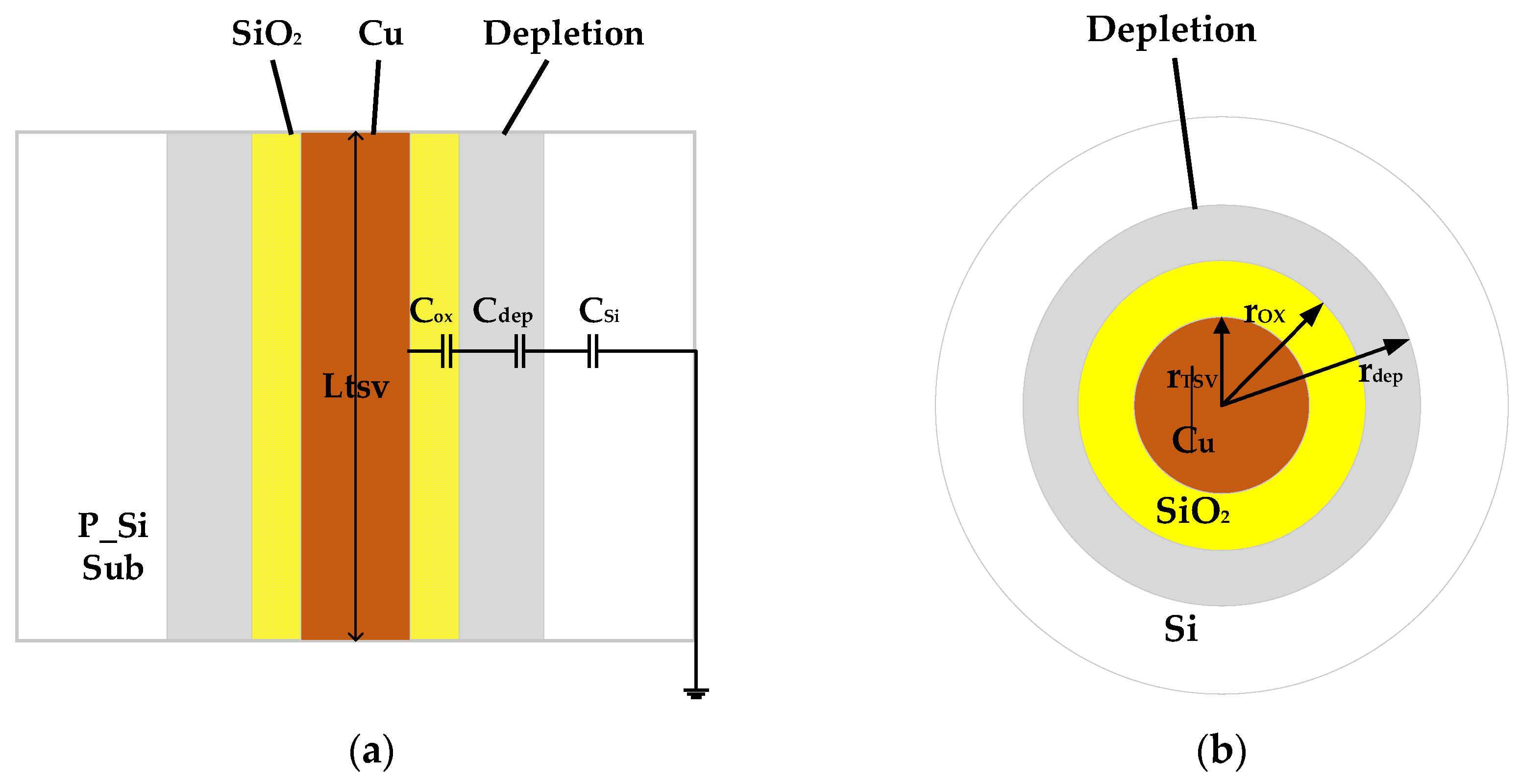
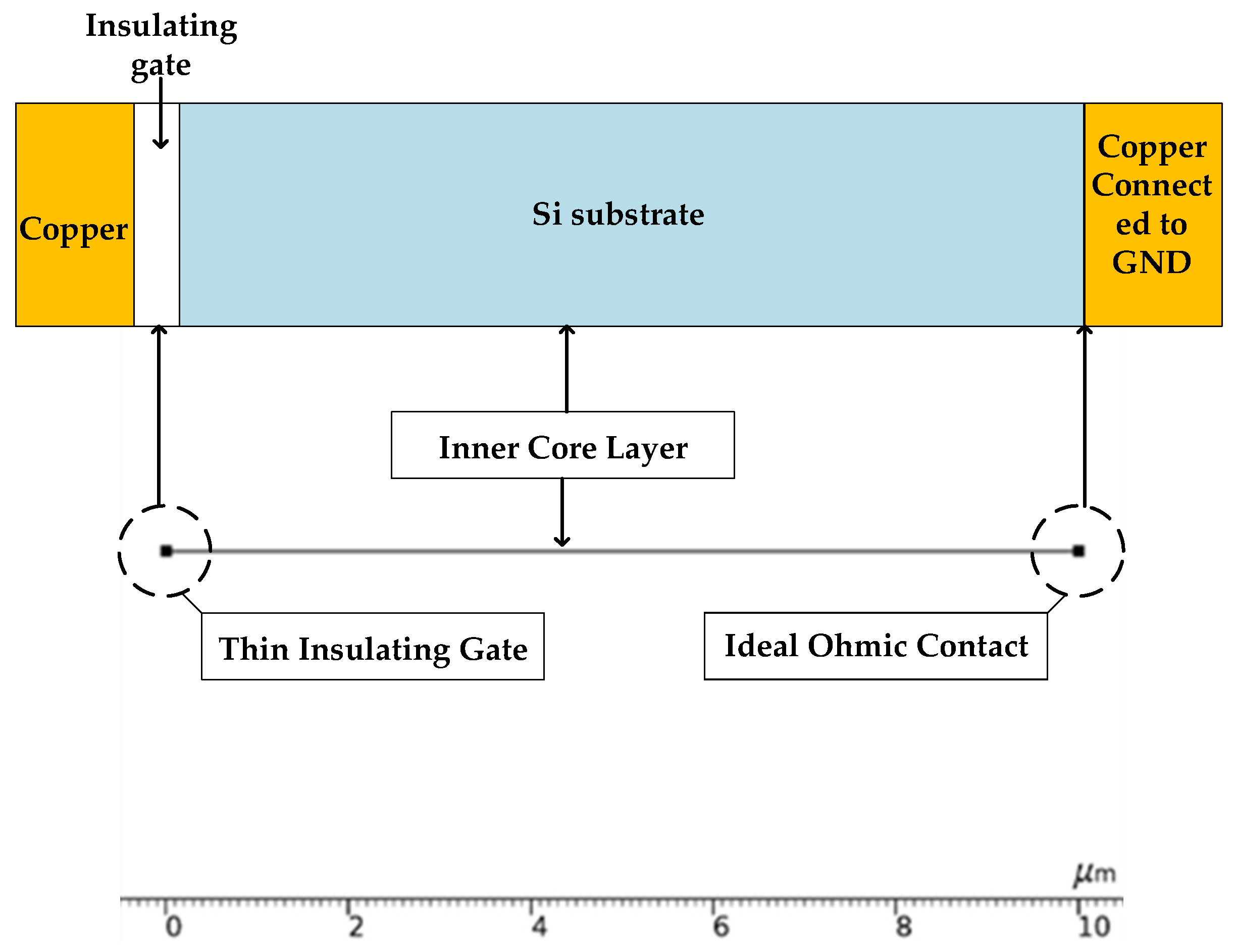


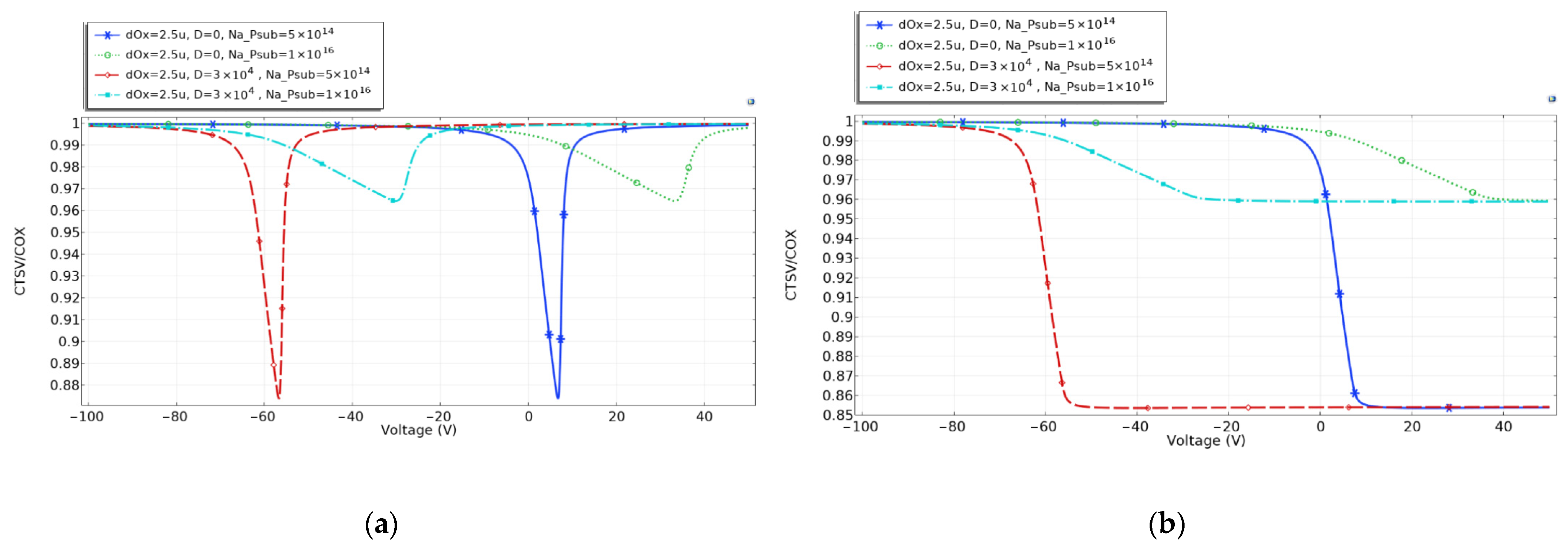
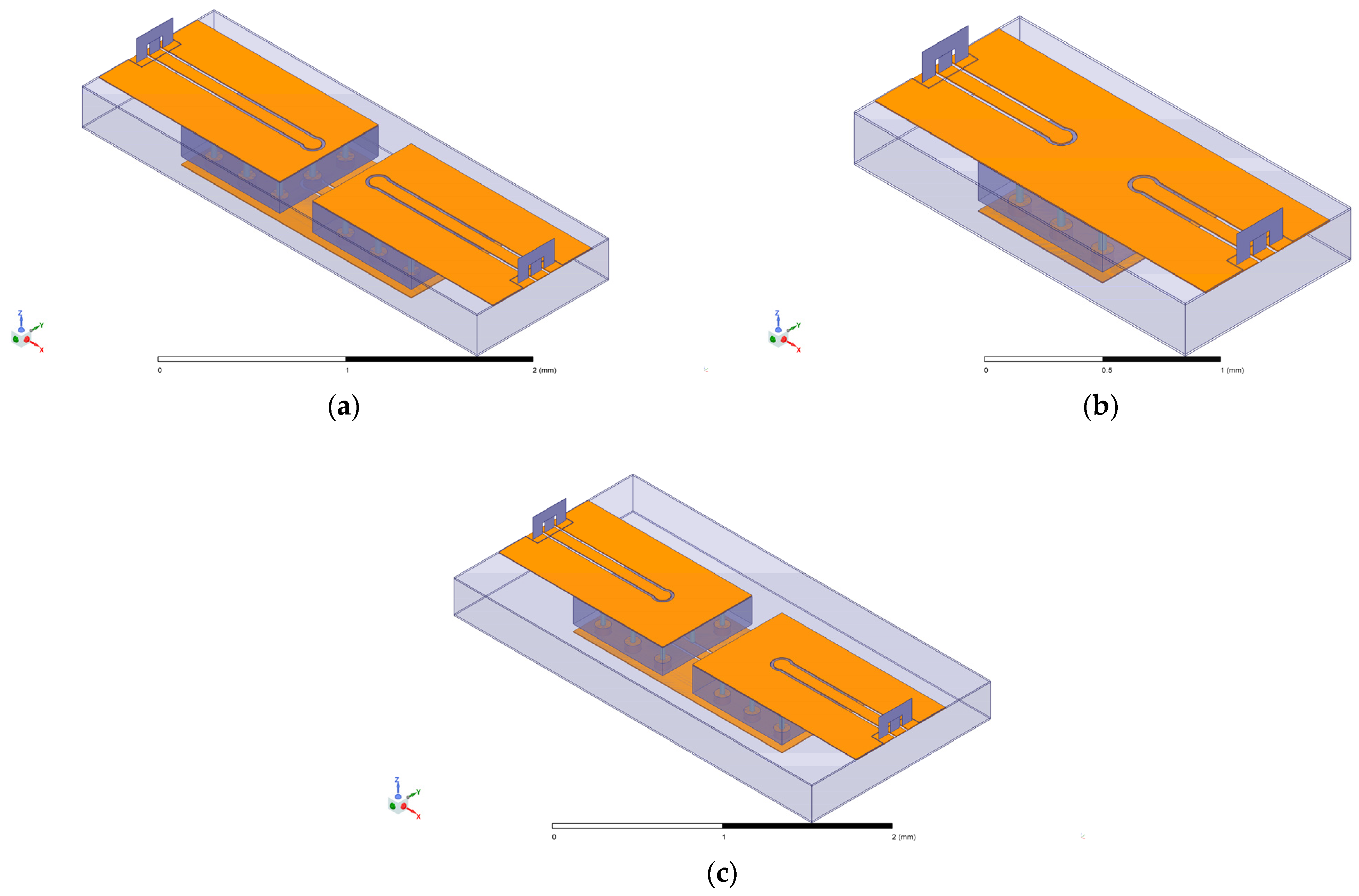
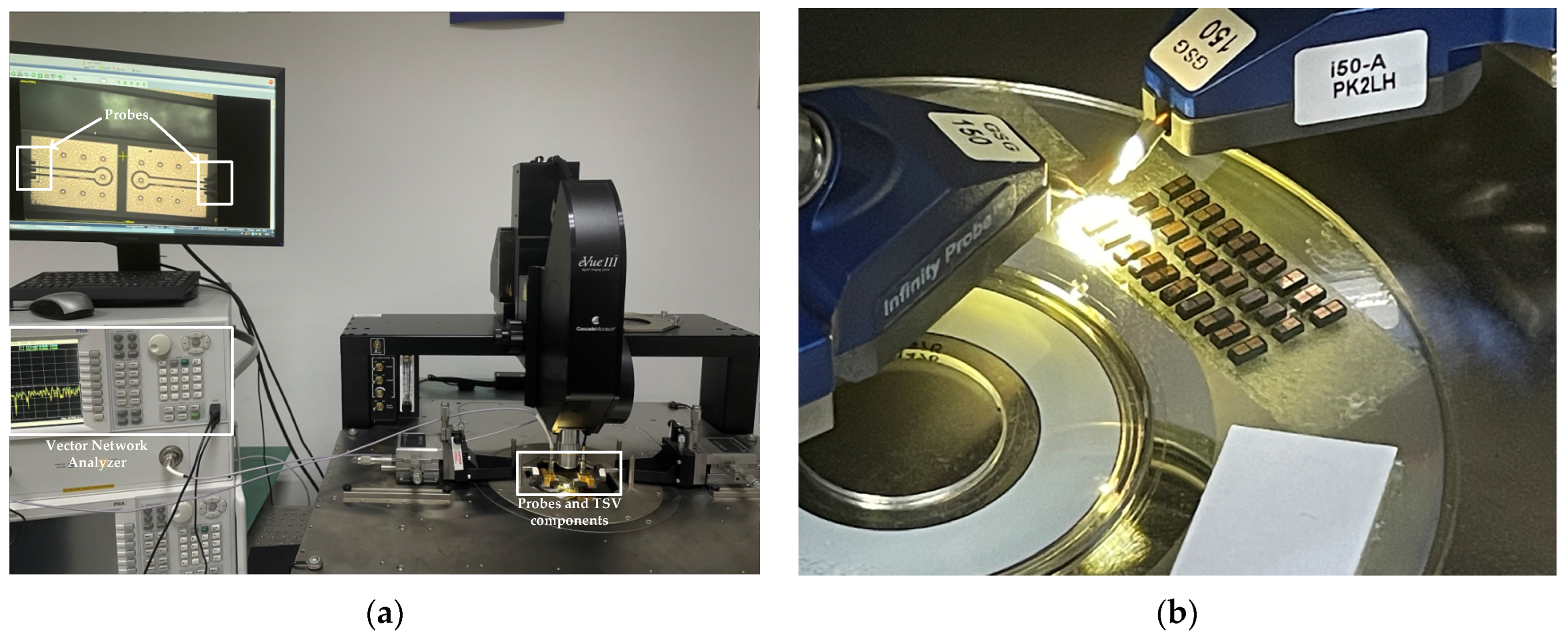
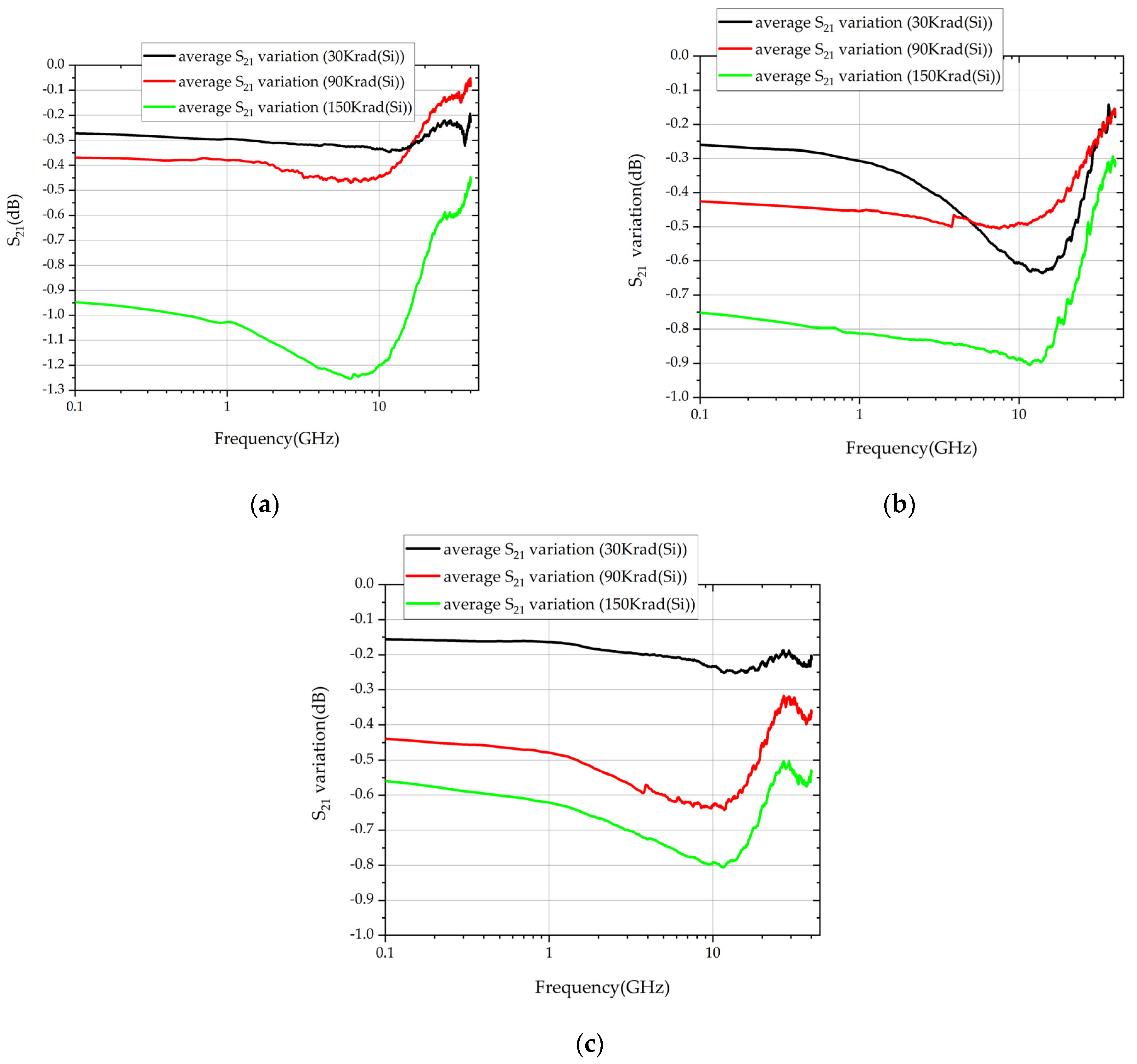



| Irradiation Dose | Experimental Conditions | |
|---|---|---|
| Irradiation Rate (rad/s) | Irradiation Time (min) | |
| 30 krad (Si) | 50 | 10 |
| 90 krad (Si) | 50 | 30 |
| 150 krad (Si) | 50 | 50 |
| The Relative Permittivity of SiO2 | 1 GHz | 5 GHz | 10 GHz | 15 GHz | 20 GHz |
|---|---|---|---|---|---|
| 4 | −0.96656 | −1.36706 | −1.43972 | −1.44308 | −1.44511 |
| 8 | −0.04377 | −0.02657 | −0.02608 | −0.03188 | −0.02888 |
| 12 | −0.06195 | −0.03464 | −0.03526 | −0.046 | −0.04344 |
| 16 | −0.06711 | −0.03547 | −0.03693 | −0.05096 | −0.04852 |
| 20 | −0.08022 | −0.03451 | −0.03634 | −0.05446 | −0.05253 |
Disclaimer/Publisher’s Note: The statements, opinions and data contained in all publications are solely those of the individual author(s) and contributor(s) and not of MDPI and/or the editor(s). MDPI and/or the editor(s) disclaim responsibility for any injury to people or property resulting from any ideas, methods, instructions or products referred to in the content. |
© 2023 by the authors. Licensee MDPI, Basel, Switzerland. This article is an open access article distributed under the terms and conditions of the Creative Commons Attribution (CC BY) license (https://creativecommons.org/licenses/by/4.0/).
Share and Cite
Yang, L.; Li, Z.; Shan, G.; Lu, Q.; Fu, Y. Modeling and Validation of Total Ionizing Dose Effect on the TSVs in RF Microsystem. Micromachines 2023, 14, 1180. https://doi.org/10.3390/mi14061180
Yang L, Li Z, Shan G, Lu Q, Fu Y. Modeling and Validation of Total Ionizing Dose Effect on the TSVs in RF Microsystem. Micromachines. 2023; 14(6):1180. https://doi.org/10.3390/mi14061180
Chicago/Turabian StyleYang, Lihong, Zhumeng Li, Guangbao Shan, Qijun Lu, and Yu Fu. 2023. "Modeling and Validation of Total Ionizing Dose Effect on the TSVs in RF Microsystem" Micromachines 14, no. 6: 1180. https://doi.org/10.3390/mi14061180






